Learn how to cook Pasta in the Instant Pot with this informative how-to guide explaining the cooking time formula, pasta-to-liquid ratio, and pressure release technique. It's the ultimate pressure cooker pasta recipe for dinner, sides, soups, and meal prep.
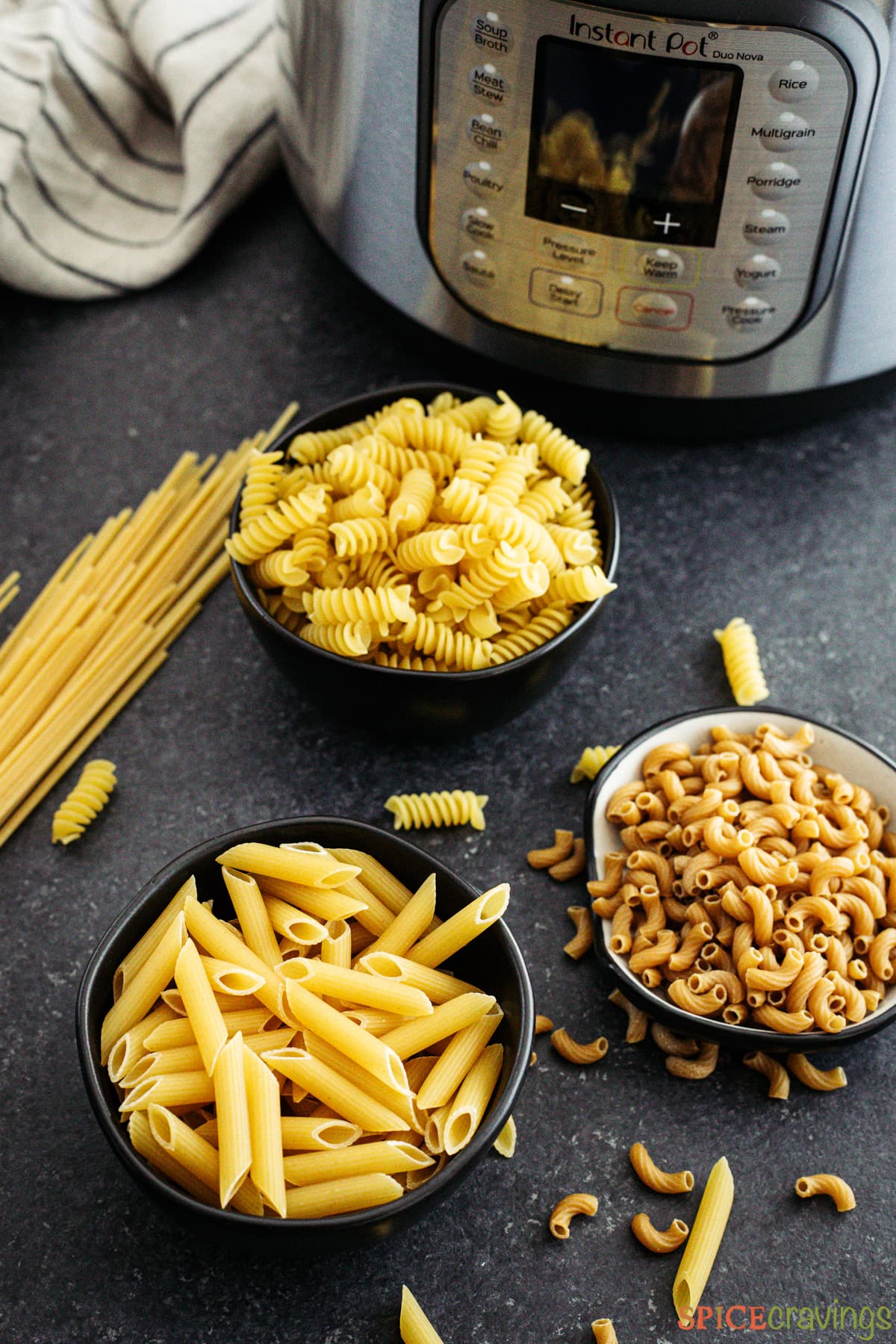
We are a pasta-loving family. It's a dinnertime staple I make at least once a week and to be honest, I love it for ease and convenience. It's a wonderful staple to have around, especially for easy meal prep throughout the week.
But rather than the traditional stovetop method, I've discovered the tried and true technique of cooking pasta in the Instant Pot. It requires less time, less effort, and less mess, which checks off all marks in my recipe book! 🙂
Jump to:
- Why Cook Pasta in The Instant Pot
- Instant Pot Pasta Formula - General Rule of Thumb
- Cooking Times for Different Pasta Shapes - How Long Does It Take To Cook Pasta in Instant Pot?
- How to Make Instant Pot Pasta
- Easy Clean-Up After Cooking
- Pasta Cooking Tips & Notes
- Frequently Asked Questions
- Easy Instant Pot Pasta Dishes
- 📖 Recipe
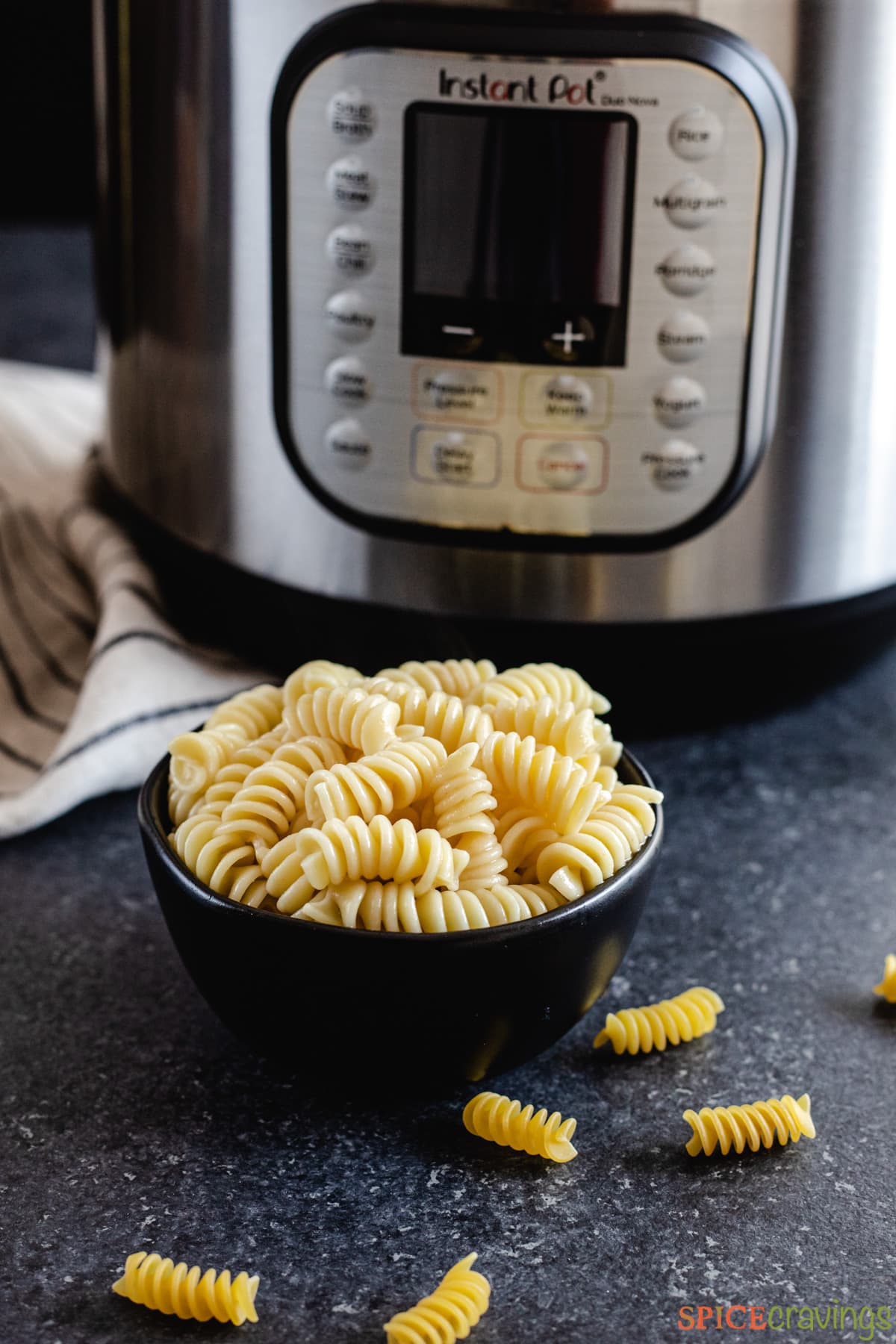
Why Cook Pasta in The Instant Pot
I love cooking pasta in my Instant Pot for my family because:
- It's a complete one-pot meal since the pasta cooks directly in its own starchy liquid, for luxuriously creamy dishes - no draining required!
- It's a set-it-and-forget-it cooking technique that results in perfect pasta every time.
- One simple formula allows you to customize the pasta firmness to your desired tenderness.
- It's a hands-off method since there is no anticipating the water to boil or babysitting a hot stove so that you can accomplish more kitchen tasks in less time.
- There is no risk of starchy cooking water overflowing and the clean-up is as easy as 1-2-3!
- It's a meal-prep delight: I can cook multiple pasta shapes in separate containers using the pot-in-pot method, and use them in different recipes throughout the week.
If you still need more convincing, check out these tried, tested, and loved Instant Pot Pasta recipes that are a hit on the blog!
Instant Pot Pasta Formula - General Rule of Thumb
Since different pasta shapes require different cook times, here is what works great for me:
Look for the suggested cook time on the box. Now, take the lower number and divide it in half. If an odd number is listed, divide that and round down. For example, if it says 7 minutes, divide that in half, which is 3.5, and round it down to 3.
This produces pasta that is well cooked and just right for my family. For an al dente pasta, or firm to the tooth, subtract one minute from that. For a softer and more tender pasta, simply add another minute to that cook time.
Whole Wheat or Gluten-Free Pasta: The cooking-time formula holds true for whole wheat and gluten-free pasta (brown rice, lentil, quinoa, etc.) varieties, too. Simply refer to the cooking time on the package and follow the calculation above.
Cooking Times for Different Pasta Shapes - How Long Does It Take To Cook Pasta in Instant Pot?
Here's an easy cheat sheet for you. By following the above rule of thumb, I've listed below a few pasta shapes and their respective cooking times in the Instant Pot:
| Pasta Shape | Pressure Cook Time (El Dente) | Pressure Cook Time (Soft) |
| Penne | 5 minutes | 6 minutes |
| Rigatoni | 6 minutes | 7 minutes |
| Fusilli | 5 minutes | 6 minutes |
| Cavatappi | 5 minutes | 6 minutes |
| Elbow Macaroni | 3 minutes | 4 minutes |
| Spaghetti | 4 minutes | 5 minutes |
| Linguine | 4 minutes | 5 minutes |
| Fettuccine | 4 minutes | 5 minutes |
| Bucatini | 4 minutes | 5 minutes |
| Rotini | 3 minutes | 4 minutes |
| Ravioli | 2 minutes | 3 minutes |
| Tortellini | 2 minutes | 3 minutes |
| Capellini | 1 minutes | 2 minutes |
Pin this chart for future reference:
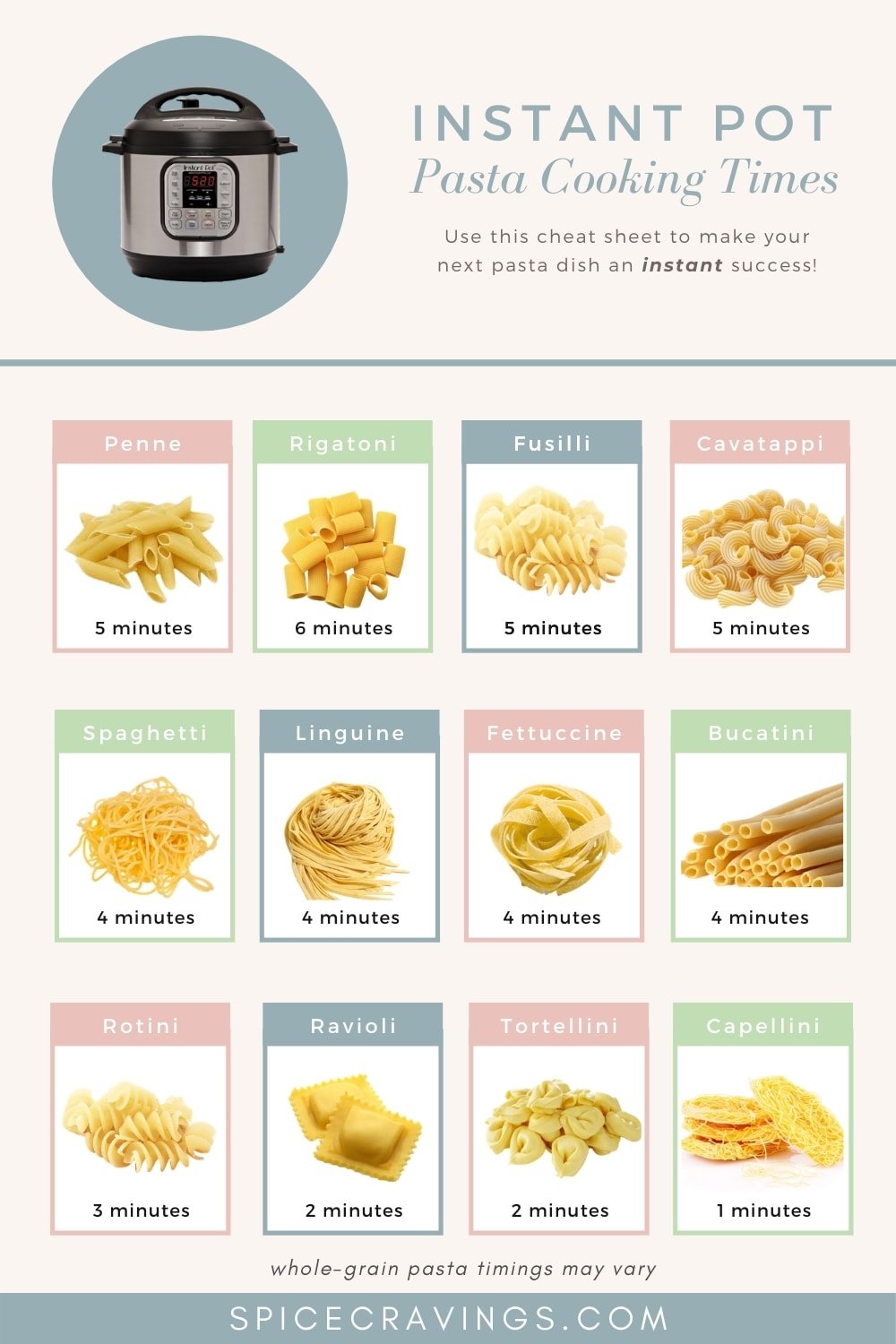
*Cooking Time Tip: For small or thin pasta shapes with a short recommended cook time (i.e. capellini), it is possible to set the timer to 0 minutes for al dente pasta. The pressure cooker will come to full pressure, but will not hold pressure for any length of time.
How to Make Instant Pot Pasta
The steps for cooking pasta in the electric pressure cooker couldn't be easier! Simply:
Add liquid and pasta: Add the recommended amount of water, pasta, salt, and oil. If cooking short pasta (penne, rigatoni, etc.), give it a stir. If cooking spaghetti or other noodle-shaped pasta, break it in half and lay it in two batches in a criss-cross pattern. Do not stir.
Set cooking time: Close the lid in sealing position. Using the rule of thumb, calculate the cooking time for your specific pasta shape. Set Pressure Cook/Manual for the calculated pasta time.
Perform an intermittent quick release: After the cooking time is done, use the intermittent pressure release technique (explained above or in notes) and release all the pressure. Open the lid when the pin drops.
Rest, sauce, and serve: Stir the pasta and separate any clumps using two forks. Let the pasta rest for 3 to 5 minutes as this lets it absorb the leftover liquid.
If the liquid is too much for your liking, you can always drain the pasta.
For a simple and satisfying meal, stir in your favorite sauce, such as spaghetti sauce or pesto.
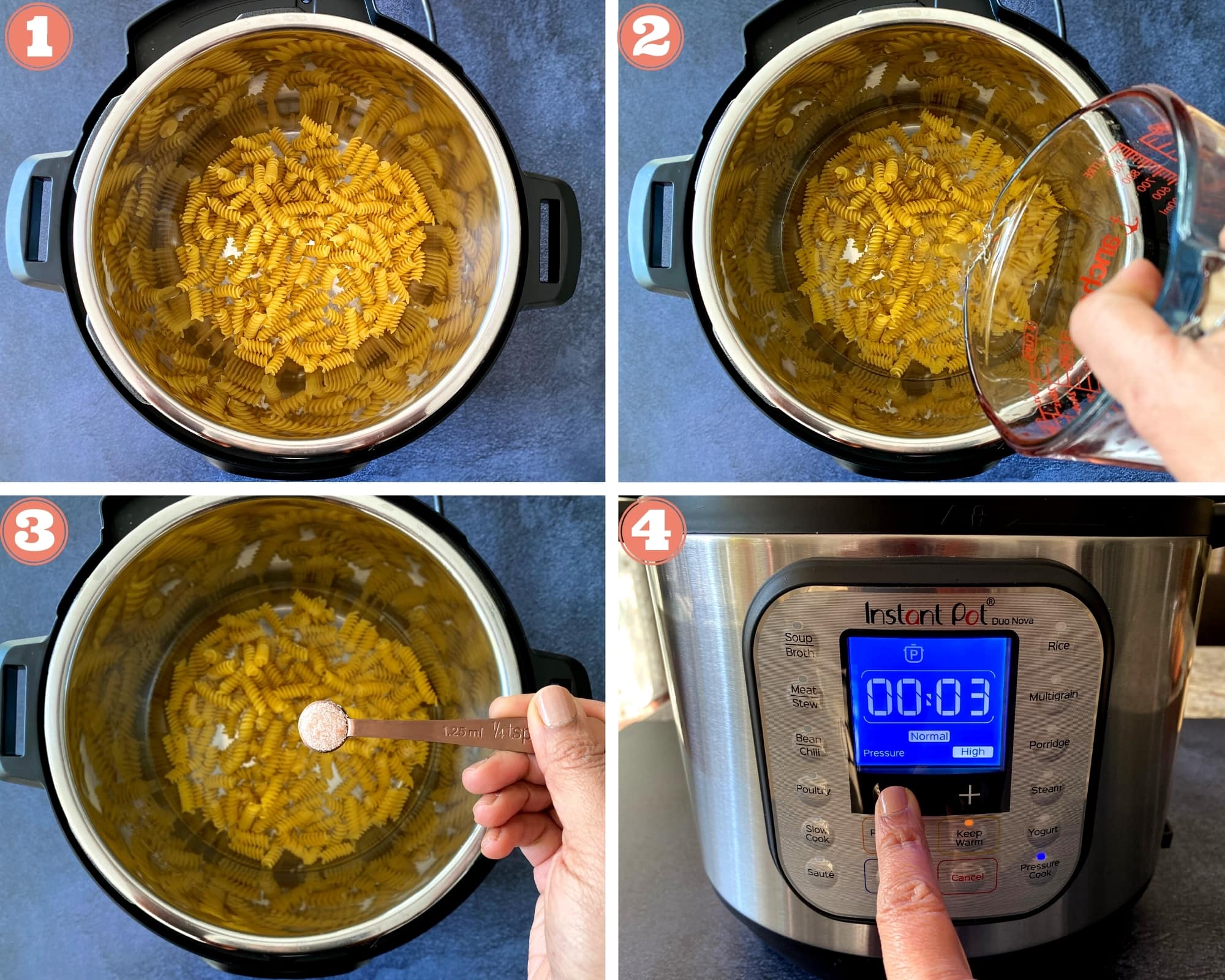
How Much Water To Use - How Much Liquid to Cook Pasta in Instant Pot?
The ratio of pasta to liquid is approximately 1:2. This can be water, clear chicken broth or vegetable stock, milk, whatever you desire. The breakdown goes as follows:
- 8 oz. pasta + 2 cups liquid
- 12 oz. pasta + 3 cups liquid
- 16 oz. pasta + 4 cups liquid
Note: Feel free to disregard this ratio if cooking pasta in a lot of liquid or sauce, such as in the case of soups and chilis. Simply follow the cooking times as mentioned above.
How To Release Pressure When Cooking Pasta
Because of the starchy cooking water in pasta, it creates a big mess after a quick release when it sprays out of the pressure knob. To avoid this, I follow one of the two methods listed below:
1. Intermittent Pressure Release
I release the pressure in bursts. This means, I press down (Ultra) or turn (Duo) the pressure knob partially to release pressure 1-2 seconds at a time, then stop. I repeat this until most of the pressure has been released and its intensity has gone down.
After that, when I do a full release of pressure, nothing squirts out of the knob.
2. NPR 5
Another way to avoid the starchy mess is to let the pressure release naturally for 5 minutes followed by a quick release. In those 5 minutes, quite a lot of pressure is released, so when you turn the knob, it won't be as intense.
However, if choosing this method, reduce the pasta cooking time by a minute to prevent overcooking it.
Easy Clean-Up After Cooking
It's important to clean the lid after cooking to rid of the excess starch and scum since this blockage can affect the next cooking cycle. To clean the lid, simply:
Wash the lid and thoroughly clean the pressure valve of the Instant Pot after cooking the pasta with a nonabrasive sponge. Wash it out with warm, soapy water and rinse clean.
Pasta Cooking Tips & Notes
- Use water, clear broth, or milk. Add enough liquid such that most of the pasta is submerged in the liquid. If using broth, reduce the salt by half and adjust the seasoning after cooking.
- Break long noodles in half. Break spaghetti, linguine, or any noodle-shaped pasta in half and lay in two batches in a criss-cross pattern. This allows the pasta to fit snugly and prevents clumping. Do not stir to prevent sticking.
- Follow the Instant Pot Pasta formula. For well-cooked pasta, take the lower number of the cooking time on the package and divide it in half. If an odd number is listed, divide that and round down. Subtract a minute from that for al dente pasta. Add one minute for softer pasta.
- Follow an Intermittent Quick Release. This prevents the starchy liquid from spraying through the pressure valve. After cooking, press down (or rotate) the pressure knob partially to release pressure 1-2 seconds at a time, then stop. Repeat this until most of the pressure has been released and its intensity has gone down. Finish with a full release of pressure.
- Alternatively, perform an NPR5. Let the pressure release naturally for 5 minutes followed by a quick release. If choosing this method, reduce the pasta cooking time by a minute to prevent overcooking.
- A few dry spots are okay. When you open the lid after releasing pressure, you may notice a couple of dry bits of pasta. This is normal. Simply stir everything, and break up larger clumps with two forks. This will help the pasta absorb the remaining liquid.
- Let the pasta rest after cooking. Once pressure is released and you've given the pasta a good stir, let it rest for 3-5 minutes. The residual heat will allow the pasta to finish cooking.
- Always add the cheese after pressure cooking: This prevents the cheese from clumping and sticking in the pot.
Frequently Asked Questions
Yes, that's exactly what this guide covers. All pasta, cooking times, and formulas are based on packages of dried pasta.
Mistakes often happen when first learning to cook Instant Pot pasta. If the pasta is seriously crunchy after the 3-5 minute rest after pressure cooking, add another ¼-½ cup water to the pot, seal it, and pressure cook for another 1 to 2 minutes.
Yes, but only in the 6 or 8-qt Instant Pot (the 3-qt is too small). For 2 pounds (32oz.) of pasta, use 8 cups water, 2 teaspoons salt, and 4 teaspoons olive oil. If using two quarts of broth, use 1 teaspoon salt and adjust the seasoning after cooking.
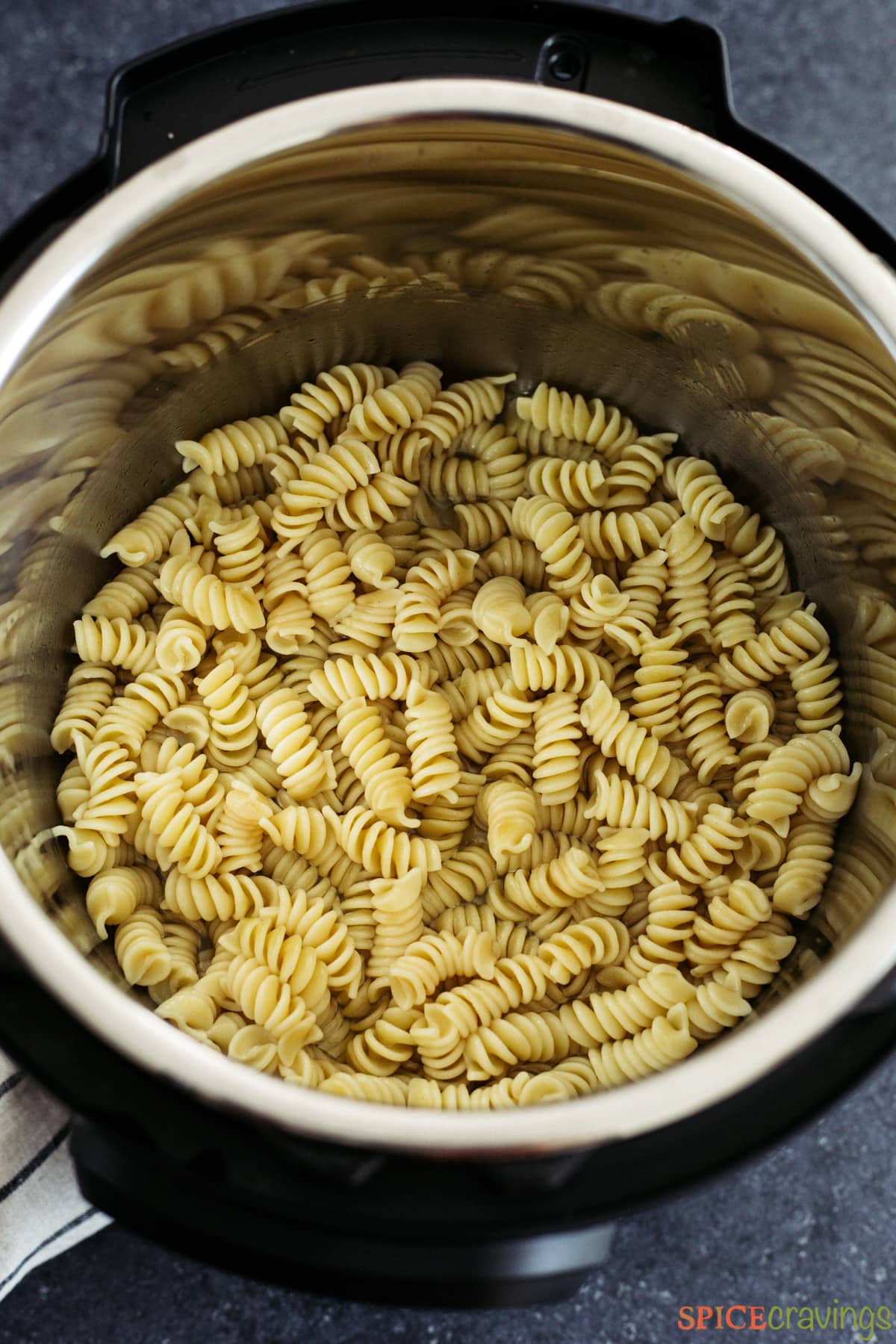
Easy Instant Pot Pasta Dishes
- Pesto Tortellini: A versatile weeknight meal, whether it's tortellini, penne, rigatoni, or spaghetti, simply tossed with this easy homemade pesto.
- Taco Pasta: A good old hearty pasta dressed up in spicy and zesty taco seasoning for an easy 30-minute Instant Pot and Stovetop recipe that's a weeknight family favorite.
- Penne Alla Vodka: A silky, glossy, and creamy Italian pasta dish with a pop of heat from red pepper and a bright finish from fresh basil.
- Creamy Mushroom Pasta: A fast and filling vegetarian meal featuring caramelized mushrooms tossed with creamy penne pasta and peas.
- Broccoli Cheddar Pasta: This family-friendly one-pot meal is everything a Broccoli Cheddar soup promises, and more that's ready in 30 minutes!
- Chicken Fajita Pasta: A satisfying and colorful dish of bell peppers, onions, penne, chicken, salsa, homemade taco seasoning, and a blend of Mexican cheeses!
- Pasta Fagioli: This hearty Italian soup that's made by simmering pasta and beans in a rich tomato broth for a complete meal ready in 30 minutes!
- Ravioli Lasagna: Creamy layers of fresh ravioli, grated Italian cheese, and tomato sauce, cooked to perfection in my Instant Pot - I call this 'Lazy Lasagna'!
- Easy Minestrone Soup: A classic Italian vegetarian soup that's warm and cozy with just the right balance of vegetables, beans, tomatoes, whole grain pasta, and spinach.
- American Goulash Recipe: A simple and delicious comfort food recipe with ground meat and pasta cooked in a tomato sauce flavored with paprika and other spices.
- Check out more Instant Pot Pasta and Noodles recipes!
★ Did you make this recipe? Please give it a star rating below! For more quick & easy recipes, FOLLOW ME on Facebook, Instagram, Pinterest and Youtube.
📖 Recipe
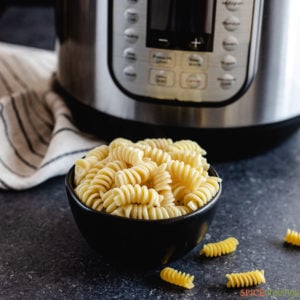
Instant Pot Pasta | How to Cook Pasta in Instant Pot
Equipment
Ingredients
Instructions
- Add water, pasta, salt and oil. If cooking short pasta (penne, rigatoni, etc.), give it a stir. If cooking spaghetti or other noodle shaped pasta, break in half and lay in two batches in a criss-cross pattern. Do not stir.
- Close the lid on sealing position. Using the rule of thumb, calculate the cooking time for your specific pasta shape. Set Pressure Cook/Manual for the calculated pasta time.
- After the cooking time is done, use the intermittent pressure release technique (explained above or in notes) and release all the pressure. Open the lid when the pin drops.
- Stir the pasta and separate any clumps using two forks. Let the pasta rest for 3 to 5 minutes as this lets it absorb the leftover liquid. For a simple and satisfying meal, stir in your favorite sauce, such as spaghetti sauce or pesto.
Notes
- Use water, clear broth or milk. Add enough liquid such that most of the pasta is submerged in the liquid. If using broth, reduce the salt by half and adjust the seasoning after cooking.
- Break long noodles in half. Break spaghetti, linguine or any noodle shaped pasta in half and lay in two batches in a criss-cross pattern. This allows the pasta to fit snugly and prevents clumping. Do not stir to prevent sticking.
- Follow the Instant Pot Pasta formula. For well cooked pasta, take the lower number of the cook time on the package and divide it in half. If an odd number is listed, divide that and round down. Subtract a minute from that for al dente pasta. Add one minute for softer pasta.
- Follow an Intermittent Quick Release. This prevents the starchy liquid from spraying through the pressure valve. After cooking, press down (or rotate) the pressure knob partially to release pressure 1-2 seconds at a time, then stop. Repeat this until most of the pressure has released and its intensity has gone down. Finish with a full release of pressure.
- Alternatively, perform an NPR5. Let the pressure release naturally for 5 minutes followed by a quick release. If choosing this method, reduce the pasta cooking time by a minute to prevent over cooking.
- A few dry spots are okay. When you open the lid after releasing pressure, you may notice a couple of dry bits of pasta. This is normal. Simply stir everything, and break up larger clumps with two forks. This will help the pasta absorb the remaining liquid.
- Let the pasta rest after cooking. Once pressure is released and you've given the pasta a good stir, let it rest for 3-5 minutes. The residual heat will allow the pasta to finish cooking.
- Always add cheese after pressure cooking: This prevents the cheese from clumping and sticking in the pot.


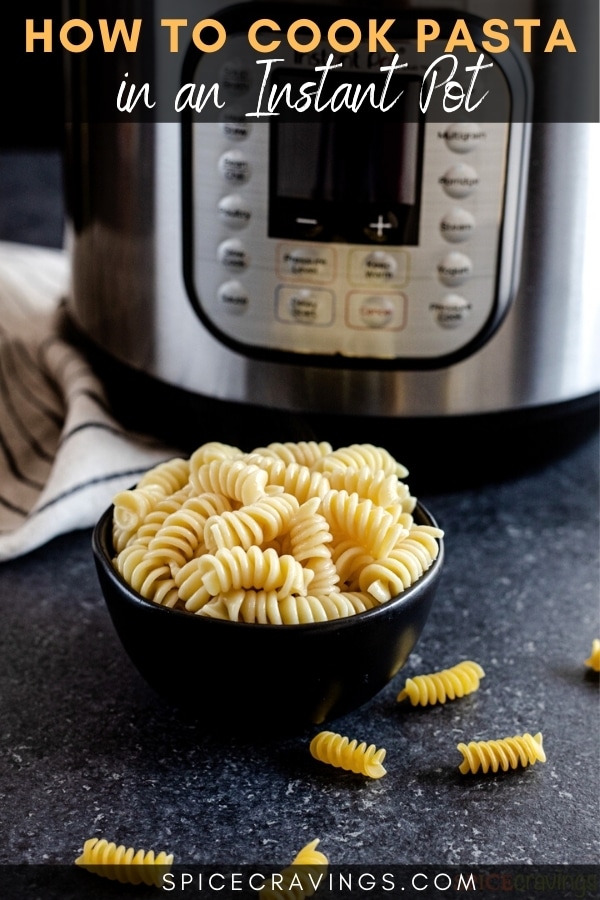
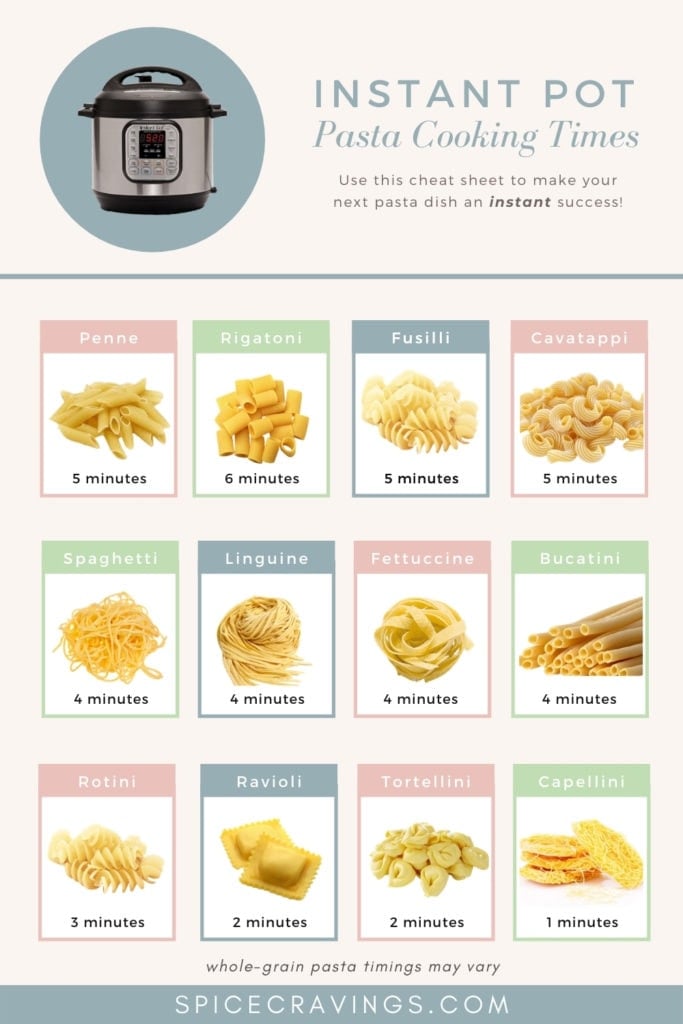
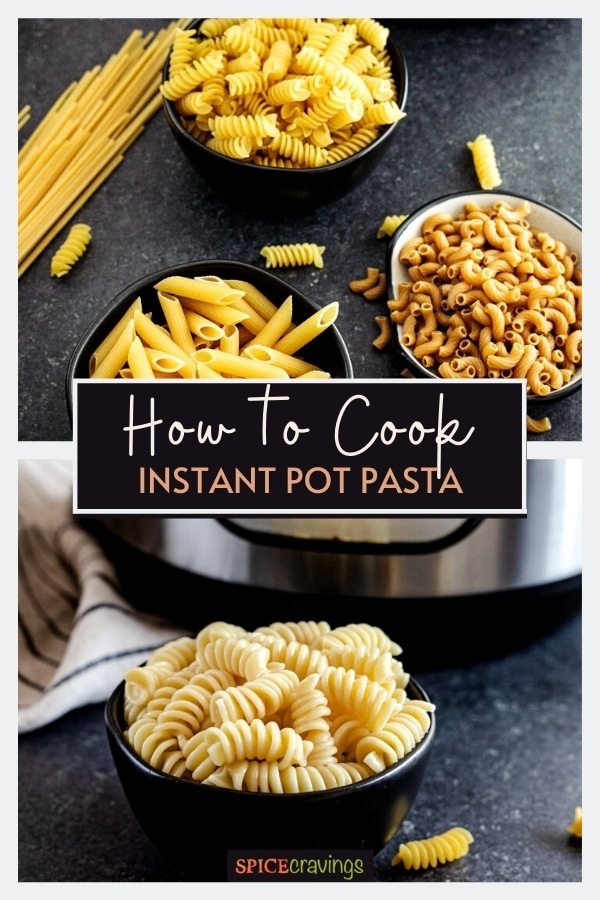
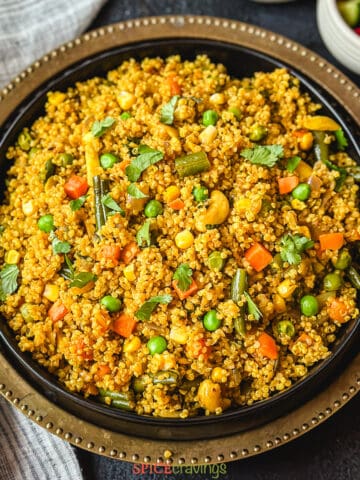
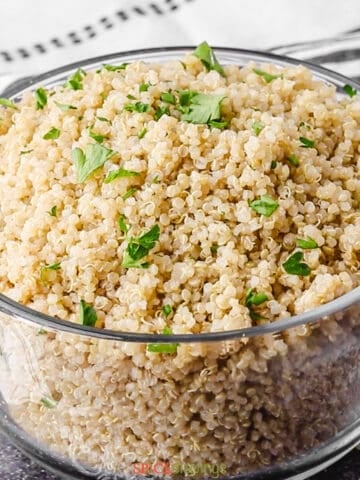
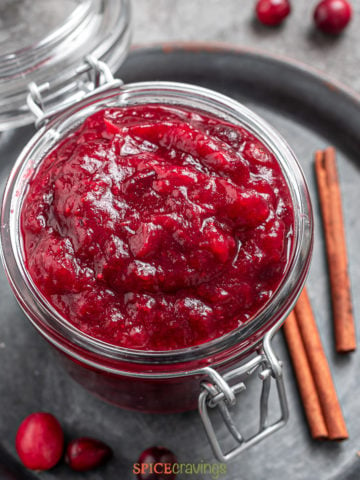
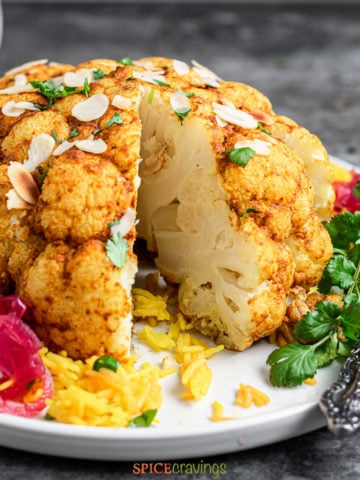

Dor says
Worked great for my rotini pasta, the only thing is there's no mention of whether to cook it on medium or high setting in the instant pot so I didn't know which to use. I used medium and it worked however!
Aneesha says
Hi Dor, the default setting is at high, so unless mentioned differently, it's safe to assume that default. I'm glad you enjoyed this paste!
Becky says
We are grandparents of an autistic child who LOVES pasta - all shapes and sizes. However, we never eat pasta. Thanks so much for your detailed recipes which I was able to convert to 4 oz for his serving. It has proven invaluable. He does not eat sauce - butter and salt only. With your help we have been able to successfully care for him away from his home for a vacation to all!! We so enjoy his company and you have provided a way to feed him successfully away from home OR drive thru places. Thanks again for the help. We have not tried curry - ever- our small town in central Texas doesn’t offer many opportunities. We plan to make that a priority when our sweet boy returns home to his parents. Can’t wait to try your recipes
Aneesha says
Hi Becky, that's the sweetest comment ever! Thank you for trusting my recipes for your family 🙏🏼 I'm so glad your grandchild enjoys them! Can't wait for you to try the curry recipes.
Melissa says
So, this is a bold statement, but I’m standing by it: these are the best instructions for cooking pasta in the instant pot/ pressure cooker! The instructions are very easy to follow and the results are great! I can’t wait to try more of Aneesha’s recipes!
Aneesha says
Thank you so much, Melissa, you made my day with your sweet comment! I'm glad you found this information helpful. Looking forward to hearing your feedback on recipes you try. Happy Cooking!
Lauren says
Don’t break the spaghetti! Lol my grandmother would be rolling over in her grave!!
If you must cook pasta in the instant pot (and I totally get it… sometimes we want quick pasta) choose a noodle that easily fits.
Spaghetti, fettuccini and other long pastas are meant to be long!
XO
The granddaughter of an Italian woman
Aneesha says
Haha- Appreciate your feedback. Just wanted to provide a way to cook all pasta shapes 🙂
Nick says
I tried someone else's tips that were a bit similar but yours was much more specific and I will def use it the next time. Question.....would adding too much water cause them to overcook? Trying to figure out if I just let them cook too long. After it was built up to pressure I immediately turned it off a d let it set for 3 min before releasing the pressure. So I tend to think I had too much water. Any thoughts?
Aneesha says
Hi Nick, thank you! I'm glad you found these tips useful! Adding more water won't overcook the pasta as long as you follow the pressure cook time. The cooker will take a few minutes more to come to pressure since it has to heat the extra water. If you let the pasta sit in the pot after the cooking time is done, it will continue to cook and will get softer. And sometimes you may have a little water left at the end, which varies with different pasta varieties. You can always drain it. I hope I was able to address your questions. Happy Cooking!
Bob Loewenthal says
2 lbs. of pasta in the 6qt sounds like a lot. Is your assessment correct?
Aneesha says
Hi Bob, Large shaped pasta will work, not small or medium. However, it's best to stick to 1 pound at a time since the pressure release becomes messy. I'll add that note to the post.
VERONICA KNOTT says
I am so thankful for the chart you shared on how many minutes per each type of pasta. I have saved this page and refer to it often. I love using the Instant Pot! One of the best appliances put on the market in a long time!
Aneesha says
Hi Veronica, thank you so much. I'm glad you found that chart useful!
Shirleyg says
Is the ratio the same for glutin free pastas.
Aneesha says
Hi there! The same formula should work. Just use the time mentioned on the pasta box and apply it to this formula.